This article is written by Prateek Singh, from Institute of Law, Nirma University, Ahmedabad. It talks about how the Directive Principles of State Policy and the State play an important part in the economic development of a nation.
Table of Contents
Introduction
The laws in India originate from the Constitution. It is an elaborative account of the ideal state of Indian powers, to ensure the existence of an egalitarian welfare state. While fundamental rights are legally enforceable and justiciable before a court of law, the Directive Principles of State Policy struggle to obtain the same gravity. India has a mixed economy, with the public and private sectors both being the participants in the economy. This article is a collaboration between the DPSPs and the role of the State. The two are interdependent in the sense that DPSPs, for their fulfillment, require the State machinery to make endeavours and the State, in doing so, fulfills its constitutional duty to ensure economic justice.
The State ensures that the policies in the DPSPs are achieved by forming laws, establishing schemes for employment, education, healthcare, provision of basic goods, housing, etc. When the State cannot directly aid its citizens, it contributes through indirect modes to satisfy its citizens and safeguard them. The State is constantly establishing schemes and policies to ensure economic upliftment of the country. It is observed that the presence of the DPSPs in the Constitution plays a pivotal role in the economic growth and sufficiency of the country.
DPSPs in economic development
The Directive Principles of the State Policy (DPSPs) are enshrined in Part IV of the Indian Constitution. They are the fundamental principles that shall be enforced by the State whilst formulating laws to ensure the welfare of society. A majority of these policies contribute directly to the economic growth and development of the State, while others act as catalysts in achieving goals that pave the way for development. The non-justifiable nature of the DPSPs forms a loophole in the attainment of a welfare State. Non-compliance with DPSPs is not challengeable in the court of law. At present, it is merely at the disposal of the State whether or not to comply with DPSPs because non-performance would not be resolvable before anyone.
The DPSP policies function by giving out mandates to the State to strive to seek the provisions laid down in Part IV. Of these, the duties of the State vis-a-vis economic development and economic justice are-
- Economic justice for the citizens of India via State-run institutions to minimise inequalities of income.
- Striving to minimise inequalities in income, status, opportunity and facilities. The State shall not only ensure individuals’ attainment of these policies but also on societal, occupational or community standards.
- Directing policies to secure equal livelihood and equal pay for people regardless of their gender, appropriate distribution of ownership and control of material resources in the most productive manner, to take measures to ensure proper allocation of wealth and avoid concentration of wealth in the hands of a few, and to ensure that citizens are not forced to work in unsuited jobs out of economic necessity.
- Establishing a legal system that provides free legal aid so that justice is not hindered due to economic incapabilities or disabilities.
- So far as the State is economically capable, it shall make provisions conferring the right to work, right to education and provide its assistance in cases of unemployment.
- Ensuring by the way of legislations or economic organisations that workers or all sectors receive a living wage, safe work conditions and shall hold a decent standard of life. Cottage industries shall also be promoted in the rural areas, either individually or on a co-operative basis.
- Making endeavours to provide free and compulsory education for all children till they attain the age of fourteen years. This is now a fundamental right under Article 21 of the Indian Constitution.
- Endeavour to organise agriculture and animal husbandry on modern and scientific lines.
The performance of the above-mentioned principles by the State is not obligatory in nature. However, the DPSPs do not possess a mere decorative value in the Constitution. The makers of the Constitution were aware of the seemingly difficult attainment of the policies in Part IV. Therefore, they made them free of any legal enforcement, but ideally, made it a legally non-enforceable duty on the State to abide by while forming laws. As a result, the governments who served India, within their capacities, established policies, formulated laws and orders to ensure that the citizens acquired the maximum benefits possible.
Importance of DPSPs in economic growth and development
The Fundamental Rights conferred upon the citizens of India are largely humanitarian. Their focal point is survival. The DPSPs focus on the survival of the people whilst improving their lives and assuring that they are the participants in economic development. They are largely socio-economic in nature. The satisfaction of social needs ensures the survival of the people, and economic growth and development ensure a higher standard of living and more accessibility to the people. It could be looked upon as a codependent cycle of needs. India is a developing nation with a mixed economy. The poverty rate in India is remarkably high, which suggests the incapability of the private sector to overlook profit-making and work on the welfare of society. In such a time, only the State is the empowered body to make changes in the economy.
DPSP and the State
The DPSPs are essential because India is a democracy, and the Governments change over the course of time. In the absence of standard moral principles, the country would go into chaos and there wouldn’t be a static set of rules common to all. However, due to the presence of DPSPs, several essential amends and additions have taken place which has ensured a better life for the people of India. They reflect the ideal functions of and expectations from the State. Their fulfillment and non-fulfillment determine whether the State is working for the benefit of its citizens or for itself.
The state performs the functions, but it is the DPSPs that act as a guiding force in determining the most basic and necessary tasks to be done. They highlight the tasks of significance. In light of the same, it could be stated that the DPSPs are necessary because they lay down the necessities. The major economic issues have already been laid down in the DPSPs. It discusses the measurement of economic justice and the minimisation of inequalities of wealth. It emphasized gender equality in various spheres of employment. Unemployment has been dealt with as a separate issue, and it has been stated that there shall be no accumulation of wealth in the hands of a few. Past records of India indicate that most of the wealth of the country was officially held by a few private market players and after the 2008 economic crisis, unemployment witnessed its all-time high. It stresses treating agriculture with an occupation of significance while stating the need to provide the industry with premium scientific techniques because agriculture is the primary occupation of the country even now.
All in all, the DPSPs cast a responsibility on the State to achieve the idealistic economic requisites of the country. The response of the State to act in accordance with the DPSPs illustrates the competency of the State, despite the non-justifiable nature of the DPSPs because they are necessary regardless and it is the duty of the State to take them into consideration at all times.
Role of State in economic development
Before the great depression occurred in the world, the governments did not interfere in the working of the markets. Everything was left to the working of the forces of demand and supply. However, after the great depression, it was considered expedient by the government to interfere in the market in order to get the desired direction, goals for the country. Fiscal policy is concerned with the raising of government revenues and incurring of government expenditures. To generate revenue and to incur expenditure the government framed the budgetary policy or fiscal policy.
- Today the State has emerged as an active participant in the process of economic development in many ways.
- The doctrine of laissez-faire has lost its relevance.
- Now the governments have assumed a new role wherein they participate increasingly in productive activities and guide the economy through their monetary and fiscal policies with a view to give it the desired direction.
- They actively determine the distribution of goods and services in the economy.
The development process for developed countries has been spread over a long period of time, but there is no time to wait for developed countries today. It is essential for them to shorten the development period. The government has an important role in the development process in this case. These countries stagnated, and this required a positive policy intervention to place them on the path of development. To that the numerous stiffnesses inherent in an underdeveloped nation, the State has to play the strategic role.
According to a UN study group, “In addition to the functions, governments normally perform, there is a large borderland of functions which they ought to perform for the simple reason that they are important, and are not carried out sufficiently, by private effort. This borderland can exist in any country, but it is wider in underdeveloped countries because private enterprise in the latter is more knowledgeable and more enterprising than in the former.”
Planning is not restricted to action in underdeveloped countries but is seen as a critical condition for economic growth. Since sources are scarce in underdeveloped countries, it becomes important to plan their distribution among different projects and to plan their use in those projects. Thus, the underdeveloped countries can not escape planning if they wish to develop themselves within a reasonably short span of time which implies that the time factor is very important. Private companies can not solve the problems that exist in underdeveloped countries and thus State intervention is important for the economic growth of these countries. It governs the output, distribution, consumption of goods and in order to accomplish this the government must formulate physical controls and monetary and fiscal steps and these measures are necessary for the economic and social disparities that exist in underdeveloped countries.
Need for intervention
Private markets cannot be left on their own. To further economic development, some socio-economic overheads are required to be established like education, health facilities, transport, and communication facilities, etc. Private companies have their own agenda, that is to expand their business and earn profits. Therefore, they will never invest in establishing these overheads as they take time to reap profits. In such a situation, the state has to emerge as an active participant in the economic development process.
Therefore, to achieve speedy reforms for rapid economic growth and development, and the role of the state is essential. Apart from this, there is the problem of income inequality, poverty, illiteracy, poor health conditions prevailing in the country. When the excess emphasis is given on industrialisation and to generate revenue, the Indian State deviates from the values of the founding fathers of the Constitution of India, which specifically considers it to be a welfare state because of the socio-economic disparities prevailing at that time in the society. Therefore, to fulfill and achieve these values, the intervention of the state is necessary other than promoting the growth of the various industrial sectors.
How to achieve
The government, through implementing measures, tries to ensure rapid economic development and up-held the principles enshrined under DPSPs. The following are some measure:
1. Changes in the institutional framework and organizational changes
- The socio-economic attitude of people needs to be changed. The rigid institutional framework is a positive hindrance in the path of development in LDCs. The people of a country must desire progress and their social, economic, legal and political institutions must be favourable to it but in LDCs these conditions are largely absent and there is a great need for a social and cultural revolution. This involves increasing business size and coordinating the labour market. The State should build the means of transportation and communications to increase market size as the private industry can not be able to pursue such schemes.
- For the population living in rural areas who are not aware of the different employment opportunities in towns and industrial areas, the government can act as a mediator by providing them information and adequate skills to get the job.
- The lack of economic overheads such as means of communications and transportations, ports, electricity irrigation etc. are one of the major hindrances in economic development. In developed countries, these are taken care of by the private players themselves. But, in LDCs this is not the case, the private players are not interested to invest because the return is not fruitful and, moreover, such huge investments are beyond the capacity of the private sector Thus, it becomes the responsibility of the State to provide these economic overheads in the under-developed countries and provide various investment areas to develop the economy.
India is more of an agrarian society that has shifted towards industrialization, this shift will result in a failure if adequate awareness, skills, and education are not provided to the people. The following are some of the policies to promote the industrialization and changing of the established framework:
-
Make in India
This was an initiative started in 2014 on 27th September. The scheme focuses on job creation and skill enhancement in 25 sectors of the economy. The initiative hopes to attract capital and technological investment in India.
-
Pradhan Mantri mudra yojana (PMMY)
Launched in the year 2015 on the 8th of April, this Yojna was started to provide funds to the non-corporate small business sector.
-
Start-up India, Stand-up India
This project was initiated in the year 2016 on the 16th of January. Its objective was to provide support to all start-up businesses. The start-ups can adopt self-certification to reduce regulatory liabilities.
-
Stand Up India Loan Scheme
The main objective of the scheme is to provide financial aid to SC/ST and women to promote entrepreneurship and employment in India. The financial aid will be provided to set up and grow businesses of SC/ST and women in need.
2. Education
A literate population will always be better than an illiterate one. Education thus plays an important role in the process of economic development. According to Myrdal, “To start on a national development programme, while leaving the population largely illiterate seems to be futile. The educational facilities provided in under-developed countries increase their geographic and occupational mobility, raising their productivity and facilitating innovations. The quality of labour is very important for economic growth.” Therefore, education should also be provided by the government.
The developed countries have made several empirical studies vis-a-vis sources of growth or factors such as physical capital and man-hours of work, education, etc. The studies, especially in the U.S. suggest that education and physical capital serve as significant sources of economic growth. Therefore, to improve the skill-sets and for the development of human resources, various training institutions should be established to provide skill-based education and provide better employment opportunities to the population. The government of India has introduced various policies over the years in order to promote education and skill development. Private Institutions can take ideas from these policies and incorporate them for more profits. Here are some of the integral policies related to education that was introduced recently:
-
No detention policy
The HRD Ministry revised the old policy for all the students from class 5th to 8th that allowed them to get promoted to the next class. Now, under the new policy, it is mandatory to clear all the examinations so as to get into the next class.
-
Compulsory gender education
The government of Telangana made gender education compulsory at the graduation level. It became the first Indian state to do so and has also introduced a bilingual textbook.
-
New education policy for girls
The government is planning to put in place a “modern education policy”. The focus of the new education policy (NEP) will be on girls’ education. It’s planning to eradicate inequality in education.
-
Eklavya Schools
Eklavya schools will be established for Scheduled Caste (SC) and Schedule Tribe (ST) students by 2022 on the lines of Navodaya schools. It will provide training in sports and skill development. It will also have special facilities for preserving local art and culture.
-
Diksha scheme
The government of India will soon launch the learning portal ‘DIKSHA’ to upgrade the teaching skills and will initiate the integrated B.Ed programme.
-
Reducing bag weight
The Department of Primary and Secondary Education is planning to introduce concepts such as “no bag day” and reducing the weight of the bag for lower primary classes.
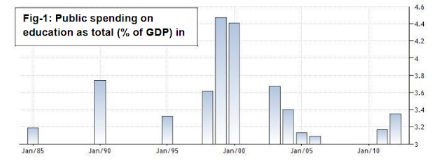
A slight observation of this graph shows that the State has reluctantly reduced a considerable amount spent on the education sector. This is a worrisome problem as because of this, the quality of education will decline, and there will be problems in the coming future.
The following tables below represent the population and literacy figures of India.

3. Removal of inequalities
There is a great social disparity between various groups of society due to the highly unequal distribution of income. In fact, economic development and social inequalities are closely related to each other. In such a scenario the government intervention is important. The government needs to ascertain various reasons as to why such inequality exists and what will be the consequence of such inequality. This helps the State in taking appropriate measures.

Fig: Income shared by Top 1%
Source: Chancel and Piketty (2017)
A careful observation of the graph will show us that there was a sharp decline in income inequality in the 1950s and 1980s but after this duration, the income inequality is on a steady rise, the income share of the top 1% is increasing. Therefore, government intervention is necessary to reduce this inequality.
Some facts and statistics relating to income inequality are:
- The top 10% of the Indian population holds 77% of the total national wealth. 73% of the wealth generated in 2017 went to the richest 1%, while 67 million Indians who comprise the poorest half of the population saw only a 1% increase in their wealth.
- There are 119 billionaires in India. Their number has increased from only 9 in 2000 to 101 in 2017. Between 2018 and 2022, India is estimated to produce 70 new millionaires every day.
- Billionaires’ fortunes increased by almost 10 times over a decade and their total wealth is higher than the entire Union budget of India for the fiscal year 2018-19, which was at INR 24422 billion.
- Many ordinary Indians are not able to access the health care they need. 63 million of them are pushed into poverty because of healthcare costs every year – almost two people every second.
- It would take 941 years for a minimum wage worker in rural India to earn what the top paid executive at a leading Indian garment company earns in a year.
Causes of Inequality
The following are some of the major contributors to inequality:
-
Difference in abilities
People are significantly different in terms of education, intellect, motivation, strength and ability. Such disparities contribute to greater differentials in income. An individual is more effective than others and earns higher pay. Differences can occur in people who have the same qualifications. Some could be smarter, more hardworking, more adventurous and more resourceful than others. They will, therefore, be at a higher degree of social standards and earn a living.
-
Differences in risk, uncertainty and security
Occupations are different as regards risk, insecurity and health. In earnings, those disparities are expressed. Owing to greater security people choose government jobs. On the other hand, private-sector work entails uncertainties and uncertainty. Employees in government jobs typically earn less than their private-industry counterparts.
-
Family influence
The ordinary graduate person will get a lucrative job through family influence whereas the brilliant scholar may end up getting a low-paid job, hence this creates a difference of unequal income through family influence.
The other factors contributing to this can be:
- Differences in environment and opportunities
- Immobility of factors
- Regional disparities
- Differences in age
- Inheritance
- Existence of non-competing groups
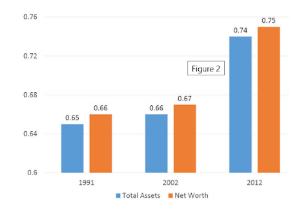
Fig: Gini coefficient of wealth (asset holdings)
The distribution of wealth provides a complementary perspective on consumption and income inequality. Wealth data points to much higher levels of inequality than either consumption or income data. The Gini coefficient for wealth based on the All India Debt and Investment Surveys (AIDIS) was 0.75 for 2012, rising from 0.67 in 2002. This inequality needs to be eradicated because even if India develops its education and health sector, it would not lead to overall growth as the persistent disparities amongst groups will result in unequal opportunities to access these basic services.
Effects of inequality
Mal-allocation of resources
There is income and wealth disparity within the economy because high-income groups have higher purchasing power, they control the community’s successful demand, and goods are generated according to their needs, as well as the resource shift of other groups according to their need.
Wastage of resources
The rich who own mines, plantations and businesses earn huge profits. They roll their wealth and spend extravagantly on conspicuous consumption, gold, jewellery, palatial building speculation etc. On the other hand, there are poor masses that live in a pathetic condition without any proper medical care, their standard of living is extremely low. So is their efficiency which leads to huge wastage of manpower of the economy. The resources are not used judiciously.
Discontentment and unrest
Incorrect distribution of income and resources in a society creates dissatisfaction and agitation among the people. This divides the country into ‘two countries,’ the haves and not haves, or the property and the non-property. The former uses the latter to gain bigger gains or revenues. All this breeds discontentment and unrest among the working classes which takes the form of agitations, strikes, and even violence.
Social injustice
Inequalities in wages and in wealth contribute to social inequality. The few at the top of the income pyramid enjoy all of the worldly comforts and luxuries without any effort, while the weary millions are working hard to earn a bare living. Such drastic disparities are socially unequal and undesirable between the wealthy and the poor.
Concentration of power
Income and wealth inequalities contribute to the accumulation of economic and political power in the hands of a few wealthy, to the detriment of the country as a whole. The rich are clever, mighty and unscrupulous. We gossip and exploit, buy leaders and statesmen more than average citizens.
4. Public health and family planning
A healthy population gives its strength back to the state in the form of an efficient workforce. Therefore, the development and maintenance of public health services are some of the important functions which are to be undertaken by the government. To improve the health condition, the primary measures adopted by the government include improving environmental sanitation, removal of stagnant and polluted water, better sewage disposal, developing the immune system of the population to control the spread of communicable disease.
As per Meier and Baldwin, public health measures affect economic development in both ways. Public health measures improve the qualitative composition of the labour force. At the same time, they also make economic development an urgent issue because of the increasing size of the population. For instance, when the death rate of the country will decrease because of the advancement in the health sector, the overall population of the country will increase which in turn leads to a burden on developing countries like India. Therefore, improvement in public health and lifestyle leads to economic growth.
To decrease poverty in any country, first, there should be a control on the population by reducing the fertility rates. To achieve this, the government can provide for family planning centres, the age of marriage can be raised, proper awareness can be provided, and incentives can be provided to parents to discourage parents from having more children. It would be important to reflect back on what are the measures the government has adopted to achieve this goal and whether they are effective or not. The following is the annual report 2015-16 relating to family planning:
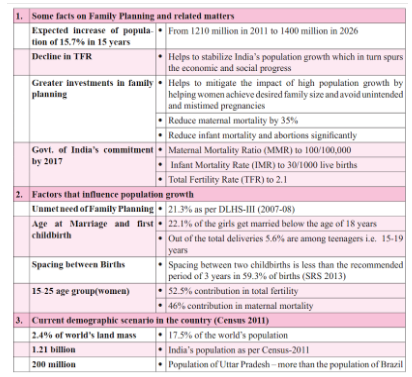
Table 4.1
The table shows the plan of the central government to control the population growth and the current position of the sub-continent.
The objectives, strategies and activities of the Family Planning division are designed and operate towards achieving the family welfare goals and objectives stated in various policy documents (NPP: National Population Policy 2000, NHP: National Health Policy 2002 and NRHM: National Rural Health Mission) and to honour the commitments of the Government of India (including ICPD: International Conference on Population and Development, MDG: Millennium Development Goals, Sustainable Development Goals-SDG, FP-2020 summit and others).

Table 4.2
It is no doubt that the figures in table 4.2 show that there is a constant rise in the population of the country from 1971 (54.82 Crores) – 2011 (121.02 Crores). But a careful look at the decadal growth rate shows that there is a constant decline of the population growth for a particular growth. Therefore, the government with the help of various awareness programmes and schemes has achieved significant success to control the population but still, a long way has to be travelled for success to come.
This can be understood in a more comprehensible manner by the following graph:
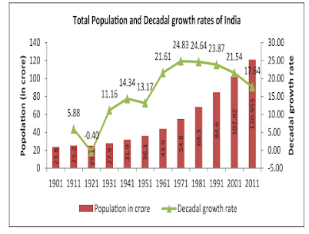
5. Agricultural development
In India ¾ of the population is based on the agriculture sector. It is the core sector on which most of the other sectors rely on, as various industries get their raw materials from this sector only. It is worth to note that this sector contributes 25% to the national income of India and is the major source of livelihood in India. Agriculture is now part of the concurrent because of the Constitution of Indian (Amendment) Act, 1954 which increased the scope of Entry 33 of Schedule 7 and included agriculture in it.
Therefore, it is clear that the State should play an active role in the development of the agriculture sector. The following are the problems which are faced by this sector and result in its backwardness:
- Poor inputs and techniques: The techniques and methods of cultivation have been old and inefficient. It results in a high cost of production and low productivity. These methods have not undergone and changed for centuries. The investment in agriculture in the form of manures and fertilizers, improved seeds, irrigation, tools and implements and other types of assets has been miserably low.
- Inadequate irrigation facilities: One of the main reasons for the weakness of Indian agriculture has been the lack of irrigation facilities in the country. The farmers have to depend upon rainfall and very few of them can avail the facilities of irrigation systems. Sometimes drought and floods also spoil the whole cultivation and crops.
- Indebtedness of the farmers: There is an old saying that the farmers in India are born in debt, live in debt and bequeath debt. The reasons for their indebtedness are many such as hereditary debt, litigation, want of supplementary incomes and wasteful social expenditure.
- Low adoption of improved technology: The adoption of high yielding varieties (HYV) is very rare in India. The important reasons for the slow growth of HYV are the non-availability of suitable seeds, the predominance of traditional seeds, the short supply of recommended seeds and the defective distribution system.
- Absence of Innovation in Agriculture: the absence of alternatives for escaping pre-monsoon showers to avoid the problem of pre-harvest sprouting of crops in flood periods is a major problem. There is a lack of improved crop management practices for shifting cultivation. The facilities of storage, processing and marketing are particularly deficient for perishable commodities.
- Rural transport and communication network: Most of the areas remain inaccessible during rainy seasons for non-availability of all-weather roads. Roads are found to be highly damaged and there are no proper transport facilities to the access of the villagers.
The other measures involving can be:
- Access or surplus labour available.
- Inadequate non-form services: Unawareness about finance and marketing activities.
- Defective land tenure structure.

Fig 5.1 Economic Structure, 1995-2016
Source: Ministry of Labour and Employment (2016); Ministry of Agriculture and Farmers’ Welfare (MAFW) (2017a); OGD Platform India (2018); World Bank WDI (2018).
Progress of agriculture sector
-
Government measures
Through the five-year plans, the government of India has played an active role in the development of agriculture. Proper objectives have been laid down in the various plans. According to these objectives, corresponding measures have been spelt out. All the activities are directed towards the achievement of these objectives.
-
Expanding government’s role
From the first five-year plan the government realized that for the development of agriculture, the government has to play an important role which would be a crucial one. Agriculture is the backbone of the economy and the poor farmers cannot uplift themselves. That is why the measures needed for the upliftment of agriculture could be taken by the government. In recent years the government’s actions have expanded to include programmes for rural development and special area programmes.
-
Laudable objectives
The objectives of different plans are varied from time to time. Somewhere the aim was to increase productivity and elsewhere to improve the quality of food grains. Land reforms have been the other significant objective. Another important objective was to uplift the weaker section of the society. For example, the small and marginal farmers, landless agricultural labourers, and many of those engaged in activities allied to agriculture such as animal husbandry and fisheries, etc.
-
Appropriate measures
In order to achieve these objectives many measures have been taken by the government of India. For example, to increase the production and productivity the supply of inputs, infrastructural facilities, an extension of irrigation, modern laboratory-based seeds, include banking, marketing, credit, transportation, communication, finance, education, and information dissemination, etc.
-
Considerable resources
Large resources have been devoted to agricultural development. These have been on the rise from plan to plan. The funding for the development of agriculture has also been increased from time to time. For the control of droughts and floods, many funds have been given by the government. Special programmes for the benefit of rural people have been introduced along with industrial development.
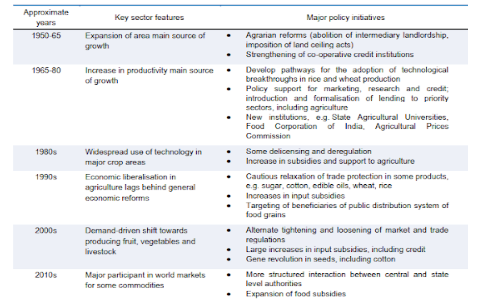
Fig 5.2 Evaluation of agriculture and policy in India
The following table shows the key features of the agriculture sector and the policy initiatives taken by the government to reach the same. The following are some policy measures that the government has implemented to improve the conditions of the farmers and the overall development of the agricultural sector:
-
Prime Minister Krishi Sinchayee Yojana
It has been formulated with the vision of extending the coverage of irrigation ‘Har Khet ko Pani’ and improving water use efficiency ‘More crop per drop’ in a focused manner with end to end solution on source creation, distribution, management, field application and extension activities.
-
Rashtriya Krishi Vikas Yojna
The NDC resolved that agricultural development strategies must be reoriented to meet the needs of farmers and called upon the Central and State governments to evolve a strategy to rejuvenate agriculture. By helping, to incentivize the states that increase their investment in agriculture and allied sectors and to achieve the goal of reducing the yield gaps in important crops.
-
NABARD
This is a development bank with a mandate for providing and regulating credit and other facilities for the promotion and development of agriculture, small-scale industries, cottage and village industries, handicrafts and other rural crafts and other allied economic activities in rural areas with a view to promoting integrated rural development and securing prosperity of rural areas, and for matters connected therewith or incidental thereto.
-
Rashtriya Krishi Unnati Yojana
Green Revolution – Krishonnati Yojana is an Umbrella Scheme in the agriculture sector that has been implemented since 2016-17 by clubbing several schemes/missions under one umbrella scheme. These schemes look to develop the agriculture and allied sector in a holistic and scientific manner to increase the income of farmers by enhancing production, productivity and better returns on produce.
-
Pradhan Mantri Kisan Sampada Yojana
It is an umbrella scheme incorporating ongoing schemes of the Ministry like Mega Food Parks, Integrated Cold Chain and Value Addition Infrastructure, Food Safety and Quality Assurance Infrastructure, etc. and also new schemes like Infrastructure for Agro-processing Clusters, Creation of Backward and Forward Linkages, Creation / Expansion of Food Processing & Preservation Capacities.
Conclusion
The government of India has initiated several relaxations for its countrymen to assure a constant decrease in the number of economically challenged people in the country. In the absence of DPSPs, determining a common set of economic guarantees would not have been possible and would’ve created chaos. With every change in the composition of the government, new policies with different targets would have emerged, leading to an eclipse of old policies.
In a country as populous as India, nationwide awareness and application of a scheme take many years. Some schemes are essential and it is necessary to continue their implementation regardless of the composition of the government. With the DPSPs, it becomes a common duty of each government to ensure that the policies under them are accomplished. As could be seen, the State is continuously striving to combat poverty and generate as much employment as possible. Free and compulsory education is necessary for economic growth since an increased rate of literacy induces the learning capabilities of people. Their skills develop. Consequently, the work-force of the country improves, leading to the achievement of more policies in the DPSPs.
References
- http://www.yourarticlelibrary.com/economics/the-role-of-education-in-economic-development/38355
- https://www.franchiseindia.com/education/13-educational-policies-introduced-by-government-that-are-changing-the-education-sector.11718
- https://mhrd.gov.in/educational-statistics-glance-2018
- https://www.wider.unu.edu/publication/inequality-india-rise
- https://www.oxfam.org/en/india-extreme-inequality-numbers
- http://naco.gov.in/sites/default/files/Annual%20Report%202015-16.pdf
- https://doi.org/10.1787/9789264302334-en
- https://vikaspedia.in/agriculture/policies-and-schemes/crops-related/pradhan-mantri-krishi-sinchai-yojana
- https://vikaspedia.in/agriculture/policies-and-schemes/crops-related/rashtriya-krishi-vikas-yojana-1/rashtriya-krishi-vikas-yojana
- https://vikaspedia.in/agriculture/policies-and-schemes/crops-related/pradhan-mantri-kisan-sampada-yojana
- https://www.economicsdiscussion.net/economic-development/role-of-state-in-economic-development/13123
LawSikho has created a telegram group for exchanging legal knowledge, referrals and various opportunities. You can click on this link and join:
 Serato DJ Crack 2025Serato DJ PRO Crack
Serato DJ Crack 2025Serato DJ PRO Crack


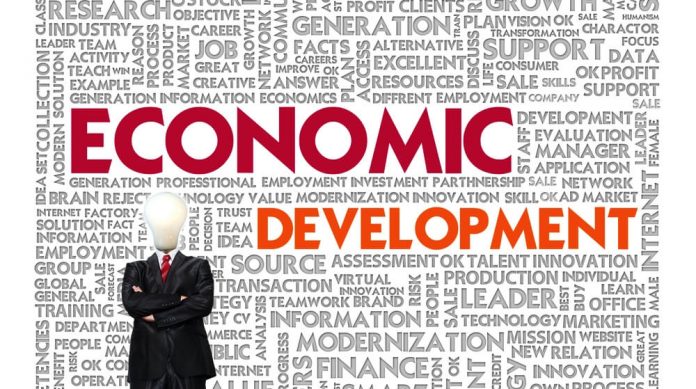




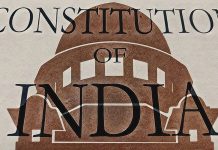
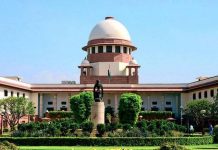
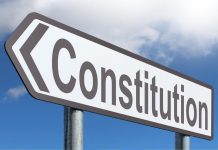


 Allow notifications
Allow notifications



